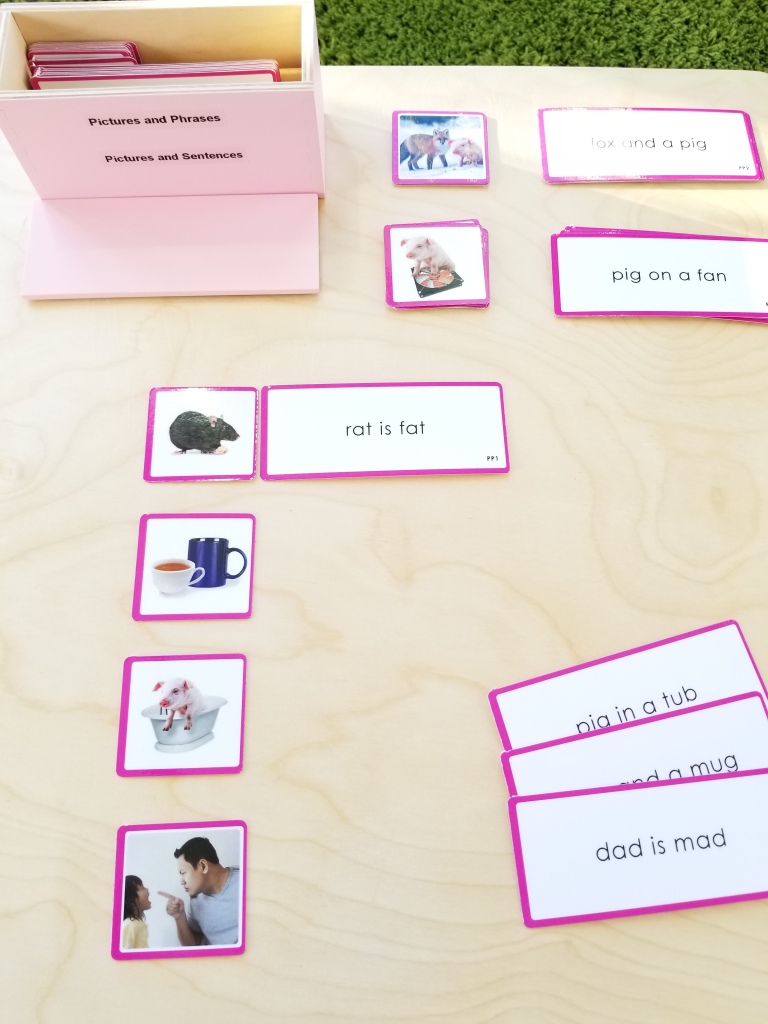- Language, 4+

- Dr. Montessori made the brilliant discovery that writing was a natural self-initiated process in children and that could be attained by providing the proper tools. However, writing could not guarantee reading, which is a more complex process.
- Therefore, following writing practice, children in the Montessori classroom can be offered different reading solutions. The Pink Language Series is a well-known and recognized method that has led children successfully through reading fluency.
- The key of the program is that it offers different means to practice C-V-C (consonant-vowel-consonant) words. Children comes to the Pink Series knowing the sounds of letters. With proper presentations, children can practice independently and progress in their reading journey.

- In this post, I would like to share Alison’s Montessori Pink Language Series, which has been designed to suit professionals and parent-educators alike. The Series comes with complete detailed guided instructions. Going through the instructions myself, I knew this was the program I will be using with my young child. I will keep the post as simple as possible to give justice to the program, which is very simple to follow!
The Pink Language Series cabinet is a perfect aesthetic addition to a prepared environment.
Step 1: Picture/Word matching

- Children are presented pairs of pictures and words to match using the same short vowel each time.
*For each step, children could always be offered extensions: using moveable alphabet, using sandpaper letters, writing on a chalkboard, making booklets, or writing on lined paper.
Step 2 – Words Booklets

- Children are invited to read the Word Booklets. This time, the words aren’t written using color coding. Each booklet focuses on a short vowel. A final booklet offers a mix of all the short vowels.
Step 3 – Word Lists

- Using Word Lists, children can unintentionally assess their progress through the program. Without the interruption of manipulating cards, children should be able to read words with more confidence.
Step 4 – Rhyming Cards

- The Rhyming Cards work comes in sets of 3 blank cards representing 3 different short vowels. Children have a set of mixed vowel cards to sort. They place these cards on the respective blank cards, which contain a control picture to guide the children.
Step 5 – Vowel Substitution

- Children are invited to use small cards, with a missing vowel in the middle, to create and read meaningful and nonsensical words. Children find this work to be very funny!
Step 6 – Command Cards

- Children can be invited to play a game. A number of cards with action verbs are set facing down. An adult select a random card and performs it for the children to guess. Once the action is guessed, the card can be read together. Again, CVC action words are used for this work.
Step 7 – Picture/Phrase matching

- This work is comprised of 3 sets of pictures/phrases to match. Children lay the pictures on the left side, and select a phrase from a pile of cards in front of them. Phrases are shorter than sentences. It is a good way to progress and build confidence in reading.
Step 8 – Picture/Sentence matching

- Matching Pictures to Sentences is the same as matching Pictures to Phrases with added reading challenge. The words are still in CVC style.
Step 9 – Command Sentences

- Command Sentences is played like Command Cards. 9 cards are placed facing down, an adult acts out the command, while children guess the action. The card is read once children have guessed correctly. This is the last work offered in the Pink Series.
- In conclusion, the Pink Language Series has the advantage to be incremental, predictable, and diverse enough to keep children’s interest high. Some reading programs can feel repetitive, and offer only one path for children to attain reading.
What next?

- The Pink Language Series is followed by the Blue Language Series, and the Green Language Series. The Blue Language Series is conducted in the same manner as the Pink Series. The Blue Language Series continue to use short vowels, while introducing blends of consonants (st-, sp-…) and diagraphs (oo, ou, ay…). Children should feel comfortable working independently towards more complex reading.
*Sight Words, also known as Puzzle Words, should be studied in parallel.

The Pink Language Series and Cabinet have been offered by Alison’s Montessori at no cost, with no obligation. I enjoy sharing with my readers honest reviews solely on Montessori materials that I believe are effective. Thank you for reading! Please leave your impressions, or questions below. I’d be happy to chat with you!
- Ready for a lesson? Please follow to receive notifications for my next reviews. Don’t miss The Blue Language Series!
Thank you so much for sharing such a thorough review. I am excited to start this in the next few months once Josie is ready! You are such an amazing resource. ❤ Felicia
LikeLike
Thank you for your words of encouragement Felicia!
LikeLike
Does this cabinet come with the purchase?
LikeLike
Hi Melissa, the cabinet is sold separately. Alison’s Montessori also sell just boxes as a compact storage solution. It’s on their website if you would like to see. Type “pink Series” to see the options.
LikeLike